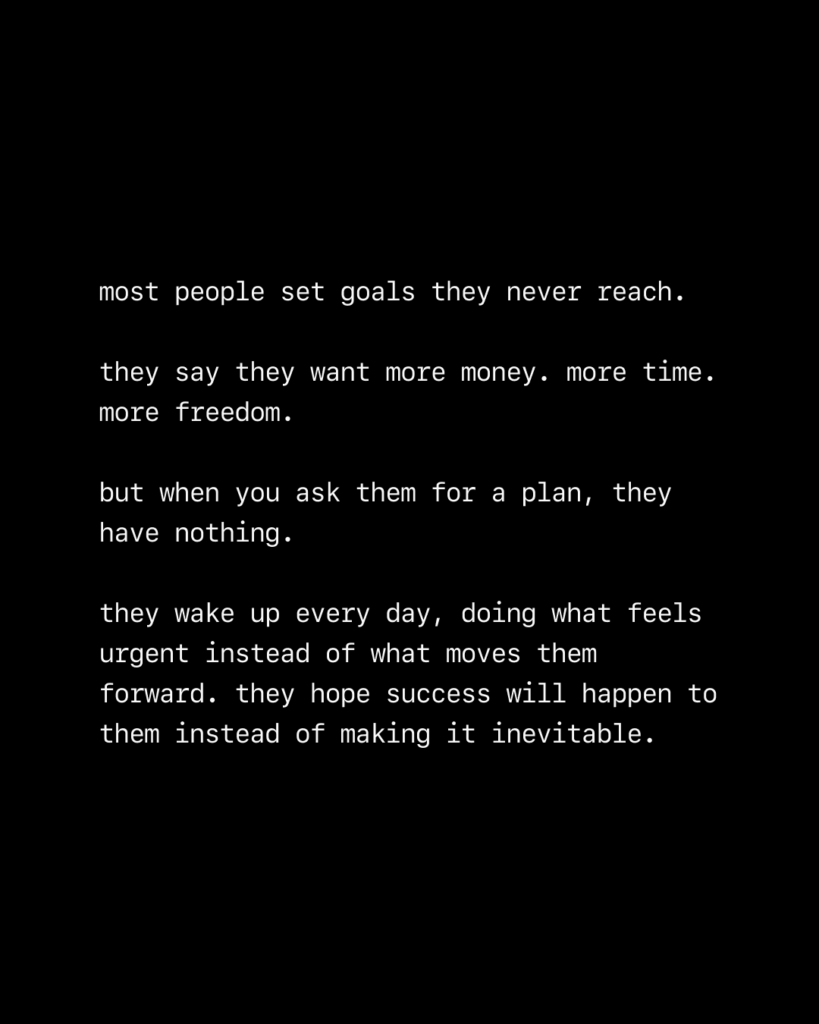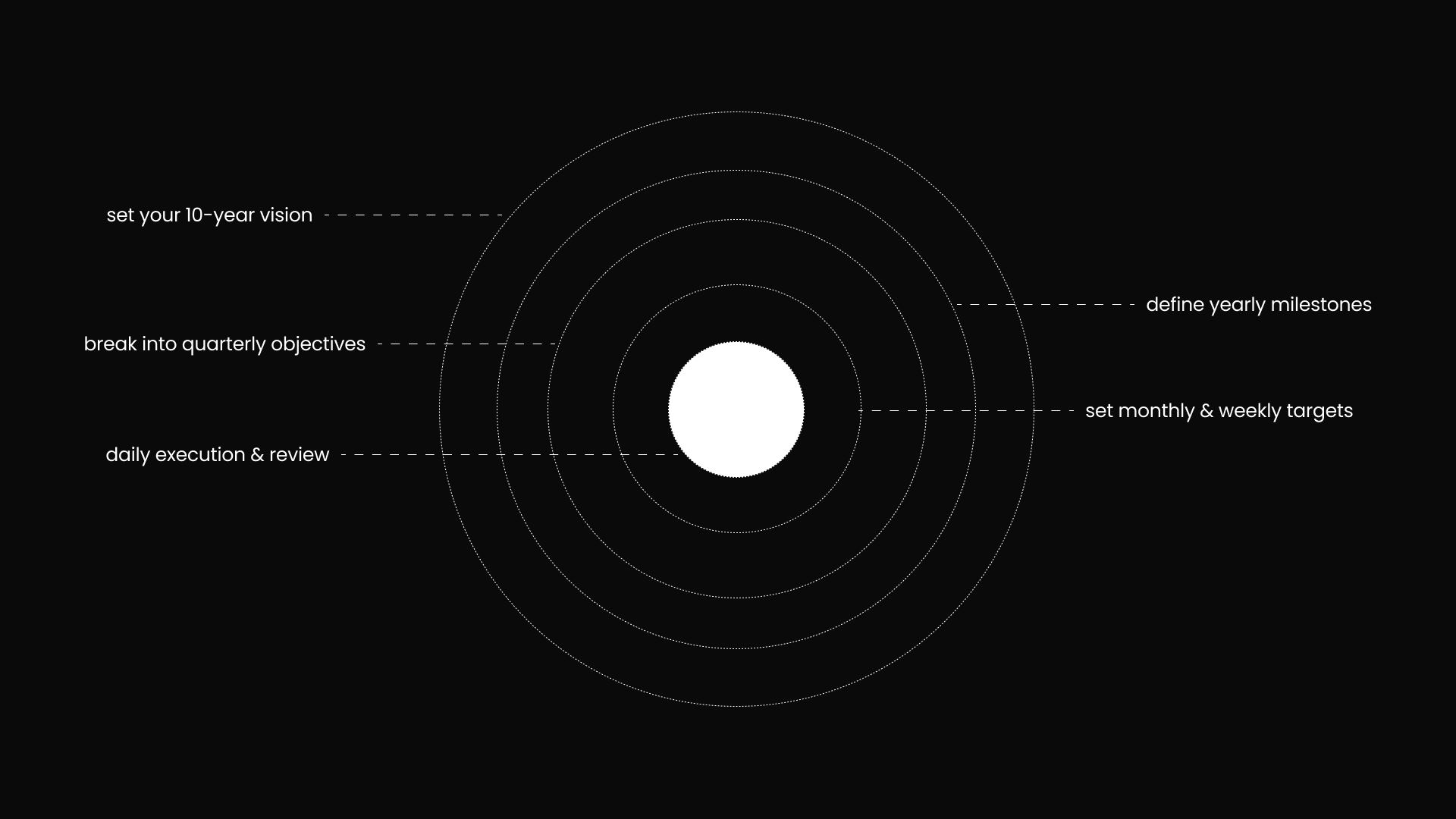Most people set goals they never reach.
They say they want more money. More time. More freedom.
But when you ask them for a plan, they have nothing.
They wake up every day, doing what feels urgent instead of what moves them forward. They hope success will happen to them instead of making it inevitable.
I used to do the same.
I had big ambitions — grow an audience, make money online, build something meaningful — but I had no structure to get there.
I thought motivation would be enough.
I believed working hard would make it happen.
It didn’t.
Because effort without direction is wasted motion.
That’s when I learned to think long-term.
Instead of setting goals and hoping for the best, I started reverse-engineering my future — breaking my 10-year vision into yearly milestones, quarterly targets, and daily actions.
Everything changed.
No more uncertainty. No more wasted time. No more wondering if I was on the right path.
For the first time, I had clarity.
And clarity beats motivation every time.
If you want to stop drifting and start building the future you actually want, you need a system.

Why Long-Term Thinking is the Key to Success
Most people overestimate what they can do in a year.And underestimate what they can do in ten.
That’s why they quit too early.
They expect success to happen fast.
They set massive goals, sprint toward them, and burn out when results don’t come instantly.
Then they call themselves failures.
Not because they weren’t capable — but because they never gave themselves enough time.
Short-Term Thinking Creates Stress. Long-Term Thinking Creates Clarity.
Without long-term thinking, you’re always reacting.
Chasing quick wins. Jumping between ideas. Trying to force success instead of letting it compound.
When you think long-term, everything slows down.
- You stop making emotional decisions based on short-term setbacks.
- You see progress as inevitable instead of something you need to force.
- You focus on the system, not the outcome.
James Clear said it best: “You do not rise to the level of your goals. You fall to the level of your systems.”
The people who win aren’t the most talented.
They’re the ones who build a system and let time do the work.
Naval Ravikant puts it even simpler: “Play long-term games with long-term people. The biggest returns in life come from compound interest — in relationships, knowledge, and skills.”
Most people don’t play long-term games.
They quit before results have a chance to show up.
A 10-year vision removes the pressure to succeed overnight.
It forces you to focus on what actually matters — showing up, executing, and letting time work in your favor.
Success is a game of patience.
Long-term thinkers don’t wait for motivation. They build systems that guarantee results.

Reverse-Engineering Your Future in 5 Steps
Most people drift through life, reacting to whatever comes next.
They work hard but without direction. They set goals but never hit them.
Not because they aren’t capable. But because they don’t have a system.
Without a clear destination, you’re just moving in circles.
Without a structured process, you’re making progress that leads nowhere.
A 10-year vision removes the guesswork.Breaking it down removes the overwhelm.
Execution turns it into reality.
This is how you engineer success instead of waiting for it.
Step 1: Set Your 10-Year Vision
Most people never think beyond the next 30 days.
They make decisions based on what feels urgent instead of what truly matters.
They chase short-term wins, jumping from one thing to the next, never building anything that lasts.
But the people who create real freedom aren’t sprinting toward instant results.
They are building something that compounds.
A 10-year vision forces you to think beyond immediate gratification.
It forces you to define what actually matters instead of what’s just convenient.
So, ask yourself:
- What kind of work do I want to be doing?
- How much money do I need to live the life I want?
- What does an ideal day look like for me?
- Who am I spending time with? Where am I living?
Write it as if it’s already real.
- I run a one-person business making $500K per year, working 4 hours a day from anywhere.
- I am in peak physical condition, training five days a week and feeling stronger than ever.
- I have complete control over my time, living without stress, and choosing my schedule.
If you don’t define it, someone else will.
Without a vision, you’ll spend your life building someone else’s.
Step 2: Define Yearly Milestones
A 10-year vision only works if you break it down.
If you don’t, you’ll look at your goal and think, “That’s impossible.”
The mind rejects what feels too big. It freezes under the weight of something that has no clear starting point.
That’s why most people never get started.
But when you reverse-engineer the outcome, you give yourself a roadmap.
Start from the end result and work backward:
- What would have to happen in Year 9 for my vision to be real?
- What needs to be in place by Year 5?
- What is the first major milestone I need to hit?
This simplifies everything.
Instead of thinking about the entire journey, you only focus on the next logical step.
Example:
- Year 1: Build an audience and establish expertise.
- Year 2: Launch a product and validate the business model.
- Year 3: Automate systems and scale income.
- Year 4-5: Expand influence, optimize for time freedom.
- Year 6-10: Sustain the lifestyle while compounding results.
Each year moves you closer.
Each step builds on the last.
No guessing. No randomness. Just deliberate progress.
Step 3: Break Into Quarterly Objectives
A year is too long to track progress.
A quarter is short enough to keep you focused but long enough to make real moves.
This is where strategy meets execution.
Most people set goals without defining the process.
They say, “I want to make $100K this year,” but never break it down into what actually needs to happen.
That’s why they fail.
A better approach is to turn your yearly milestone into four 90-day objectives.
Example for Year 1 (Building an Audience):
- Q1: Write weekly content and post daily.
- Q2: Grow an email list and test engagement.
- Q3: Launch a small digital product and validate interest.
- Q4: Optimize content strategy and refine the offer.
Each quarter has a clear focus.
Each focus compounds into the next.
No wasted motion. Just stacked momentum.
Step 4: Set Monthly & Weekly Targets
Big goals don’t happen all at once.
Every quarter needs to be broken down into monthly execution plans.
Every month needs to be tracked through weekly priorities.
A simple structure:
- At the start of each month: Identify one main focus.
- At the start of each week: Define three key actions.
- Every day: Execute 2-3 essential tasks that move the goal forward.
Small actions compound into big results.
Most people fail because they focus on tasks instead of leverage.
The difference:
- A task keeps you busy.
- A lever moves everything forward.
If you’re spending all day on low-impact tasks, you’ll feel exhausted but have nothing to show for it.
If you focus on high-impact levers, you’ll achieve 10x the results with 1/10th of the effort.
Every action you take should move the big picture forward.
Step 5: Daily Execution & Review
Discipline isn’t about forcing yourself to work harder.
It’s about removing confusion.
When you wake up knowing exactly what to do, execution becomes automatic.
Two things make this happen:
- A clear plan – so you never waste time figuring out what to do.
- A review system – so you stay on track and adjust when needed.
Every Sunday, review progress:
- What worked?
- What didn’t?
- What needs to change?
The biggest mistake most people make? They set goals but never track their progress.
If you aren’t measuring, adjusting, and refining, you’re guessing.
This is why most goals fail.
Not because they were impossible. But because there was no system in place to make them inevitable.
Success is built one deliberate action at a time.
Long-term thinking isn’t just about having a vision.
It’s about structuring your life so that success becomes automatic.

Your Future Isn’t Random — It’s Engineered
Most people stay stuck because they never define what they actually want.
They set vague goals, chase short-term wins, and wonder why nothing changes.
They believe success is about working harder. But effort without direction is wasted motion.
Long-term thinkers don’t work harder. They work deliberately.
They set clear targets.
They reverse-engineer their goals.
They break them into small, consistent actions.
They remove confusion so execution becomes automatic.
This is how you move from reacting to designing your future with intent.
Your Challenge
This isn’t theory. It’s a process.
You don’t need more motivation. You need a structured system that eliminates resistance.
Right now, write down your 10-year vision.
Where do you want to be in:
- Career?
- Finances?
- Health?
- Relationships?
Then, break it down:
- Define your yearly milestones. What needs to happen each year?
- Set quarterly objectives. What must be completed every 90 days?
- Establish monthly & weekly targets. What’s the focus for the next 30 days?
- Commit to 2-3 daily actions. What will move the needle today?
- Review and refine. Track progress and adjust along the way.
Success is never about doing more.
It’s about doing less of what doesn’t matter and more of what compounds.
You don’t have to figure everything out today.
You just have to start.
Clarity beats motivation. Systems beat effort. Execution beats overthinking.
Most people will read this and do nothing.
Be different.
Decide where you want to be — and start moving toward it today.

